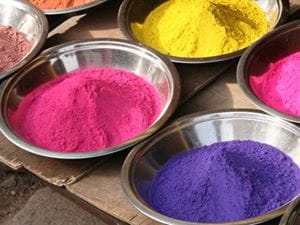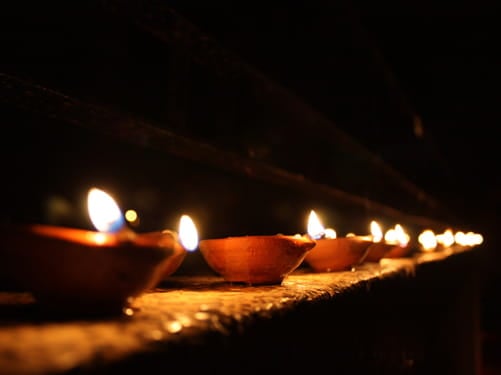
Holi is a lively Hindu festival celebrating the arrival of spring. It dates back to texts from the 11th century and is connected to both deities and rites of spring. You may know it best from images of Eat, Pray, Love where villagers toss vibrant colored powders onto each other and dance in the streets with joy. Holi falls around the time of the vernal equinox – what in Western tradition would be the first day of spring. The deep meaning of Holi is connected to different Indian legends and their symbolic messages. The focus may vary depending on the part of India and the world where it is celebrated. Holi celebrates the story of a pure-hearted devotee, Prahlad who underwent many trials to maintain his faith as well as the burning of carnal desires by Shiva to reach a higher level of love. The stories, rituals and meanings behind them follow.
The Legend of Prahlad and Holi
Prahlad loved the Divine more than anything. This isn’t easy when your father is Hiranyakashipu, the king of demons. While Prahlad worshiped the Divine in the form of Lord Vishnu, Prahlad’s father persecuted him. He gave his son poison, but in his mouth it turned into nectar. He ordered that Prahlad be trampled by elephants, but again God protected him. He was placed with poisonous serpents, but they didn’t strike him. Finally, he ordered Prahlad to sit on a burning pyre on his sister Holika’s lap. Holika had been given a boon by one of the gods that she could withstand fire. Prahlad bowed to his father’s command, but when the pyre was lit, Prahlad was protected while his sister burned to ashes. The name for the Holi festival and the bonfires are derived from Holika’s name.
Shiva Burning Away Desires on Holi
Another legend associated with Holi is the story of Shiva and Kama, the lord of desire. Shiva is renowned for remaining undisturbed in deep meditation, but Kama sought out Shiva in order to stop a powerful demon who was destroying the earth. Only a seven-day-old child issuing from Shiva himself could stop the carnage. The people sought the help of Kama, the god of love and desire in Hindu mythology, so that Shiva might marry Parvathi and bear a child. Kama found Shiva in deep meditation and shot arrows at him to draw him out. But Shiva only opened his third eye and burned Kama to ash. The devas pleaded that Shiva restore Kama, and he was restored in ethereal form, representing a higher form of love. His intimate friend is Vasanta or the Spring. Shiva and Parvathi came together and gave birth to a son who killed the demon. The story represents releasing lower desires for desire for divine love.
Naturally Colorful Celebrations
The colors of Holi celebrate the renewal that arrives with the flowers and colors of spring. The colors were traditionally made from flowers, herbs and roots with medicinal value which may have been considered to act as protection against fevers and illness associated with the change of season. The powders were made from neem, turmeric, beetroot and its juice, henna and other natural plants. Red, green, yellow, blue and black powders fly from rooftops and in crowded squares and the festival transcends classes and caste. The colors used which were once made naturally from flowers are now often artificial. Environmental movements encourage a return to natural colors. The festival is celebrated over several days and may include creating beautiful and intricate rangoli or kolam patterns at the thresholds of houses as a way to bless visitors and those who enter.
Families also gather around a bonfire where an effigy of Holika is burned to recall the triumph of Prahlad and the burning of his evil sister. Like many spring festivals around the world, it may also represent the burning away of the dullness of winter. Lord Krishna and his consort, Radha, are also associated with Holi. The day after the burning of Holika, some people place the ash from the fire mixed with sandalwood paste on their foreheads. Though for many people it is a secular holiday, Holi ultimately signifies the triumph of good over evil and of sensual values over spiritual ones.
Holi Around the World
As the Indian population grows, Holi is becoming a familiar festival celebrated on campuses and at Hindu and Indian homes worldwide. Elders may share stories and legends of Holi while families cook special dishes, decorate homes and exchange gifts. In Nepal, Holi is a national holiday. It’s also celebrated in England, South Africa and elsewhere around the globe.

